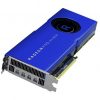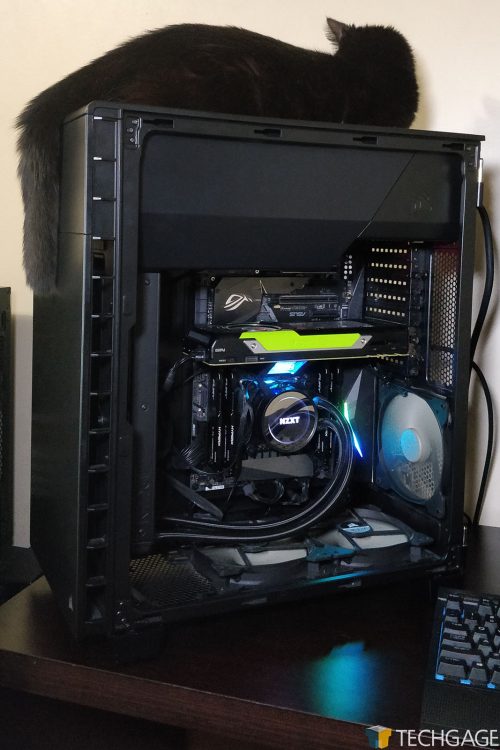- Qualcomm Launches Snapdragon 4 Gen 2 Mobile Platform
- AMD Launches Ryzen PRO 7000 Series Mobile & Desktop Platform
- Intel Launches Sleek Single-Slot Arc Pro A60 Workstation Graphics Card
- NVIDIA Announces Latest Ada Lovelace Additions: GeForce RTX 4060 Ti & RTX 4060
- Maxon Redshift With AMD Radeon GPU Rendering Support Now Available
AMD’s Affordable Workstation Vega: Radeon Pro WX 8200 Review

For those who need a workstation graphics card that should slaughter benchmarks, not wallets, AMD’s Radeon Pro WX 8200 is worth checking out. This Vega-based WX sports a ton of cores for great compute and graphics performance, as well as 8GB of ECC HBM2 memory. But how does it serve your workload? Let’s figure that out.
Page 1 – Introduction & Testing References
I posted an in-depth look at AMD’s Radeon ProRender renderer last week, and in that article, I mentioned that the workstation side of Radeon has been on fire as of late. New ProRender versions are coming out left and right, and in August, we were even greeted to a brand-new Radeon Pro GPU: the WX 8200.
With the name “WX 8200”, the card is a bit of an oddball given the (X)100 naming seen before it. With the 8200, AMD effectively introduces the second release cycle for Radeon Pro, though I’m not sure it’s safe to call it “second gen”. Nor would I want to call it that – the WX 8200 is similar in hardware to the RX Vega 56, and the WX 9100 is like a Vega 64 – both are of the same generation.
Nonetheless, the WX 8200 offers a lot for its price-point in the workstation market. It’s capped at 8GB memory, which might throw some off, but it’s at least ECC (error correction), which is not something we see at the $1,000 price-point often (or ever?). With 3,584 Vega cores under-the-hood, the WX 8200 is no slouch when it comes to raw performance, either for compute, or gaming.
The only cards in AMD’s Radeon Pro lineup to beat out the WX 8200 in performance would be the WX 9100 and SSG. Both of those cards have 4,096 cores, and a full 16GB of memory. The SSG is special in that it has 2TB of SSD storage on the card itself (four drives in RAID 0), allowing the GPU to get even closer to the project cache (eg: with Adobe Premiere Pro), in effect removing a middleman in the transfer.
| AMD’s Radeon Pro Workstation GPU Lineup | |||||||
| Cores | Base MHz | Peak FP32 | Memory | Bandwidth | TDP | Price | |
| SSG 9 | 4096 | 1440 | 12.3 TFLOPS | 16 GB 8 | 484 GB/s | 260W | $6999 |
| WX 9100 | 4096 | 1200 | 12.3 TFLOPS | 16 GB 8 | 484 GB/s | 230W | $1399 |
| WX 8200 | 3584 | 1200 | 10.8 TFLOPS | 8 GB 8 | 512 GB/s | 230W | $999 |
| Frontier | 4096 | 1382 | 13.1 TFLOPS | 16 GB 4 | 484 GB/s | 300W | $499 |
| Pro Duo | 2304 x2 | 1243 | 5.7 TFLOPS | 32 GB 3 | 448 GB/s | 250W | $449 |
| WX 7100 | 2304 | 1188 | 5.73 TFLOPS | 8 GB 3 | 224 GB/s | 130W | $549 |
| WX 5100 | 1792 | 713 | 3.89 TFLOPS | 8 GB 3 | 160 GB/s | 75W | $359 |
| WX 4100 | 1024 | 1125 | 2.46 TFLOPS | 4 GB 3 | 96 GB/s | 50W | $259 |
| WX 3100 | 512 | 925 | 1.25 TFLOPS | 4 GB 3 | 96 GB/s | 50W | $169 |
| WX 2100 | 512 | 925 | 1.25 TFLOPS | 2 GB 3 | 56 GB/s | 50W | $129 |
| Notes | 1 GDDR6; 2 GDDR5X; 3 GDDR5; 4 HBM2 5 GDDR6 (ECC); 6 GDDR5X (ECC); 7 GDDR5 (ECC); 8 HBM2 (ECC) 9 Includes 2TB of solid-state storage on-card. Architecture: WX 2100~7100 = Polaris; WX 8200, 9100 & SSG = Vega Tested GPUs are italicized |
||||||
The WX 8200 is a great all-around card thanks to its $999 price-point and the amount of performance it offers. It’s not going to beat out the competition in all tests, but it performs extremely well in a few tests. For comparison’s sake, the performance results here also include the Vega 64, so we can easily see which tests benefit from RPro performance optimizations, and which don’t.
I remember when the WX 9100 launched at $2,199, but here we are, with the same card being sold regularly for around $1,399. Even before looking at the results, I’d have to wager that if I were choosing to go with a WX 8200, I’d think long and hard about whether or not I’d ever want more than 8GB of memory, and the extra performance. You don’t gain an enormous amount by stepping up to the WX 9100, but it’s what I’d consider the more future-proofed card.
Test PC & What We Test
On the following pages, the results of our WS GPU test gauntlet will be seen. The tests chosen cover a wide-range of scenarios, from rendering to compute, and includes the use of both synthetic benchmarks and tests with real-world applications from the likes of Adobe and Autodesk.
14 GPUs are being tested for this article, although because we had a second TITAN Xp on-hand, dual-GPU results will also appear throughout. If the dual-GPU configuration isn’t found in a chart, it means there was no performance scaling whatsoever across the multiple cards.
Here are the specs of the test machine:
| Techgage Workstation Test System | |
| Processor | Intel Core i9-7980XE (18-core; 2.6GHz) |
| Motherboard | ASUS ROG STRIX X299-E GAMING |
| Memory | HyperX FURY (4x16GB; DDR4-2666 16-18-18) |
| Graphics | AMD Radeon RX Vega 64 8GB (18.10.1) AMD Radeon RX 580 8GB (Red Devil; 18.10.1) AMD Radeon Pro WX 8200 8GB (18.Q3.1) AMD Radeon Pro WX 7100 8GB (18.Q3.1) AMD Radeon Pro WX 5100 4GB (18.Q3.1) AMD Radeon Pro WX 4100 4GB (18.Q3.1) AMD Radeon Pro WX 3100 4GB (18.Q3.1) NVIDIA GeForce RTX 2080 Ti 11GB (NVIDIA FE; 416.34) NVIDIA TITAN Xp 12GB (416.34) NVIDIA GeForce GTX 1080 Ti 11GB (416.34) NVIDIA Quadro P6000 24GB (416.30) NVIDIA Quadro P5000 16GB (416.30) NVIDIA Quadro P4000 8GB (416.30) NVIDIA Quadro P2000 5GB (416.30) |
| Audio | Onboard |
| Storage | Kingston KC1000 960GB M.2 SSD |
| Power Supply | Corsair 80 Plus Gold AX1200 |
| Chassis | Corsair Carbide 600C Inverted Full-Tower |
| Cooling | NZXT Kraken X62 AIO Liquid Cooler |
| Et cetera | Windows 10 Pro build 17763 (1809) |
| For an in-depth pictorial look at this build, head here. | |
Benchmark results are categorized and spread across the next four pages. On page 2, Adobe’s Premiere Pro and MAGIX’s Vegas Pro lead our encoding tests, with both AVC and HEVC codecs taken care of. On the same page, Sandra’s financial and scientific performance can be seen, as well as the cryptography.
On page 3, a few renderers are taken care of. These include the popular open-source design suite Blender, as well as LuxMark, and Radeon ProRender. ProRender is being tested with the help of 3ds Max, a suite that normally handles Redshift and V-Ray as well – but alas, neither work (or work well) on AMD graphics cards.
Page 4 is home to viewport performance, covered with the help of SPEC and its SPECviewperf suite, as well as Cadalyst, and its namesake AutoCAD test. In total, 9 test results are featured here, covering important design suites like CATIA, SolidWorks, Siemens NX, Creo, as well as Autodesk’s 3ds Max and Maya.
Finally, page 5 is home to a couple of gaming tests (more for sanity checks, since gaming isn’t going to be a huge focus here), as well as final thoughts.
So without further ado, let’s get this train moving.
Support our efforts! With ad revenue at an all-time low for written websites, we're relying more than ever on reader support to help us continue putting so much effort into this type of content. You can support us by becoming a Patron, or by using our Amazon shopping affiliate links listed through our articles. Thanks for your support!






